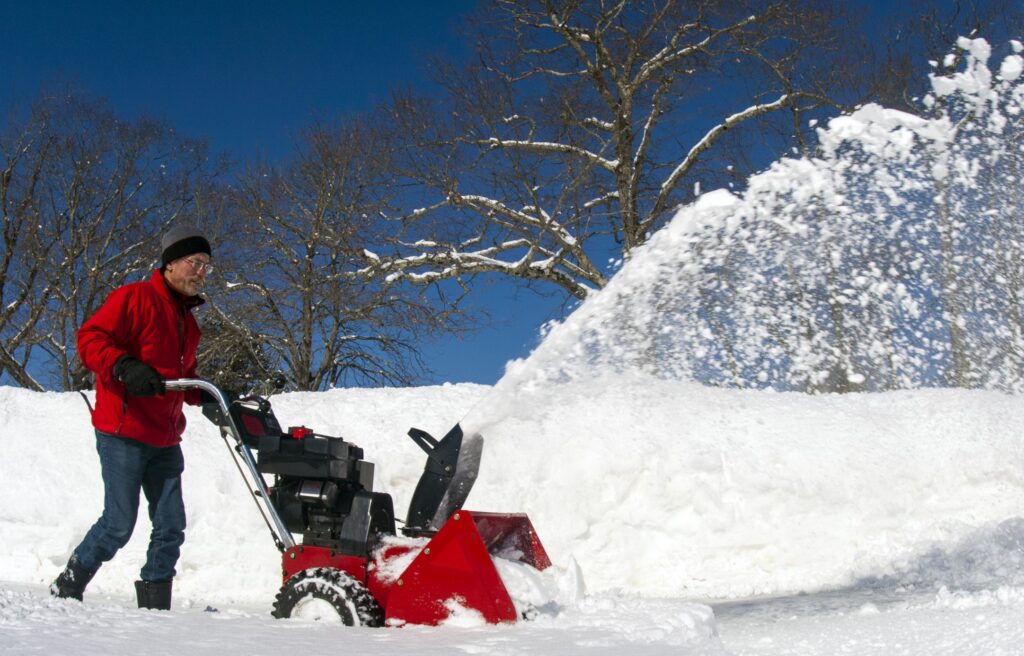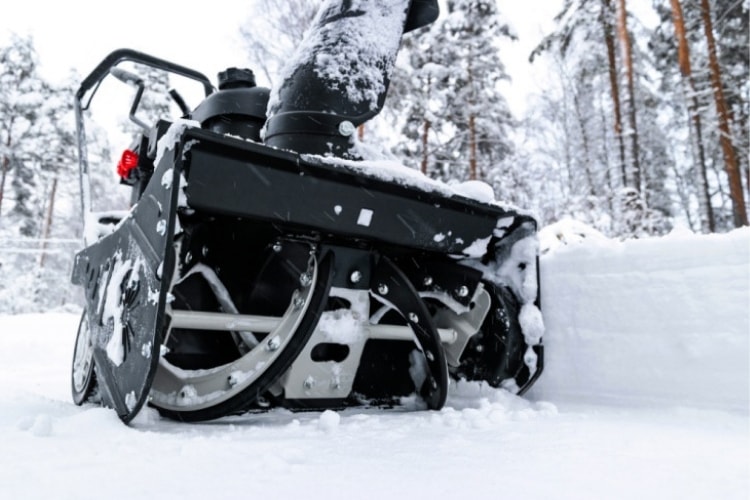Hey there! Have you ever wondered whether you should leave gas in your snowblower? We’ve got the answer for you! Let’s dive into it and find out what’s best for your snowblower and your peace of mind.
When it comes to leaving gas in your snowblower, the consensus among experts is that it’s generally best to drain the fuel at the end of the snow season. This is because gasoline has a tendency to go bad over time and it can cause starting problems for your snowblower in the next season. Additionally, leaving gas in the tank can lead to the corrosion of key components, such as the carburetor, which can be costly to repair.
However, if you plan on using your snowblower regularly or if you live in an area where it’s constantly cold and you may need to use it sporadically throughout the year, it might be a good idea to leave a small amount of gas in the tank to keep the engine lubricated. We’ll explore this more in our article to give you a better understanding of what works best for your specific situation.
So, whether you should leave gas in your snowblower or not depends on various factors. Stay tuned as we delve deeper into this topic and provide you with all the information you need to make an informed decision.
The Importance of Emptying the Gas Tank
Preventing Fuel Degradation
Leaving gas in a snowblower can lead to fuel degradation over time. When gasoline is left sitting for an extended period, it can break down and become less effective. This can result in poor performance and difficulty starting your snowblower when you need it most.
Avoiding Engine Damage
In addition to fuel degradation, leaving gas in your snowblower can also pose a risk of damage to the engine. The gasoline can varnish and clog the carburetor and fuel lines, leading to costly repairs or even the need for a replacement engine.
Preventing Clogs and Blockages
Gasoline that sits in the fuel tank for a long time can develop sediment and debris. When this contaminated fuel is used, it can clog the fuel system and cause blockages. A clogged fuel system can prevent the engine from running smoothly or starting altogether.
Proper Storage Techniques
Draining the Fuel System
One of the best ways to avoid the problems associated with leaving gas in a snowblower is to drain the fuel system completely before storing it. This can be done by running the snowblower until it runs out of gas or by using a fuel siphon to remove the gasoline from the tank. By ensuring that there is no fuel left in the system, you can minimize the risk of fuel degradation and clogs.
Using Fuel Stabilizer
If you choose to leave gas in your snowblower, using a fuel stabilizer can help to prevent fuel degradation. Fuel stabilizers work by slowing down the oxidation process and extending the shelf life of gasoline. This can be particularly useful if you live in an area with long periods of snowfall or if you anticipate not using your snowblower for an extended period.
Running the Snowblower Dry
Another method for preparing your snowblower for storage is to run it until the fuel is completely depleted. This can help prevent any leftover gas from sitting in the fuel system and causing issues when you go to start it up again. By running the snowblower dry, you are essentially removing all the fuel from the system, minimizing the risk of clogs and blockages.

This image is property of www.snowblowersdirect.com.
Benefits of Leaving Gas In Snowblower
Quick Startup
One of the main benefits of leaving gas in a snowblower is that it allows for quick and easy startup. When the snow starts falling, you don’t want to waste time filling up the fuel tank and waiting for the engine to warm up. By leaving the gas in the snowblower, you can simply turn the key or pull the starter cord and be ready to tackle the snow in no time.
Avoiding Fuel System Damage
Contrary to popular belief, leaving gas in a snowblower can actually help to protect the fuel system from damage. When there is fuel in the system, it acts as a protective barrier against moisture and rust. This can be particularly beneficial if you store your snowblower in a garage or shed that is prone to humidity or temperature changes.
However, it is worth noting that this benefit is more relevant for shorter periods of storage. If you plan on storing your snowblower for an extended period, it may be more beneficial to empty the gas tank to prevent fuel degradation and other issues.
Risks of Leaving Gas In Snowblower
Fuel Degradation
As mentioned earlier, leaving gas in a snowblower can lead to fuel degradation over time. Gasoline can break down and lose its effectiveness, resulting in poor performance and difficulty starting the engine. This can be particularly problematic if you live in an area with long periods of snowfall, as you may not use your snowblower for months at a time.
Carburetor and Fuel System Issues
Leaving gas in the snowblower can also lead to problems with the carburetor and fuel system. Over time, gasoline can varnish and clog the small passages in the carburetor, leading to engine performance issues or the need for costly repairs. Additionally, sediment and debris that may accumulate in the fuel tank can also cause blockages in the fuel system, resulting in engine problems.

This image is property of sp-ao.shortpixel.ai.
How Long Can Gas Stay in the Snowblower?
Factors Affecting Gas Shelf Life
The shelf life of gasoline can vary depending on several factors. These include the type of gasoline used, the presence of ethanol, and storage conditions. Gasoline that contains ethanol has a shorter shelf life compared to non-ethanol gasoline. Additionally, extreme temperatures and exposure to moisture can also accelerate fuel degradation.
Recommended Storage Duration
In general, it is recommended to avoid leaving gasoline in a snowblower for more than 30 days. However, if you plan on storing your snowblower for an extended period, it is best to empty the gas tank completely to prevent fuel degradation and potential engine issues.
Other Factors to Consider
Climate Conditions
The climate conditions in your area can also play a role in how long you can leave gas in your snowblower. If you live in an area with high humidity or fluctuating temperatures, it is more important to empty the gas tank to prevent fuel degradation and potential engine damage.
Frequency of Snowblower Use
If you use your snowblower frequently throughout the winter season, leaving gas in the tank can be more beneficial. Regular use of the snowblower helps to prevent fuel degradation and keeps the fuel system running smoothly. However, if you only use your snowblower occasionally or during specific snowfalls, it is best to empty the gas tank to avoid potential issues.
Manufacturer Recommendations
It is always a good idea to consult the snowblower’s manufacturer recommendations regarding fuel storage. They may provide specific guidelines on how to store your snowblower and whether or not it is advisable to leave gas in the tank. Following the manufacturer’s guidelines can help ensure optimal performance and prevent any unnecessary damage to your snowblower.
This image is property of lh6.googleusercontent.com.
Proper Fuel Maintenance
Using Fresh Gasoline
To ensure optimal performance and prevent fuel degradation, it is important to use fresh gasoline in your snowblower. Avoid using gasoline that has been sitting in a container for a long time, as it may already be starting to break down. Instead, purchase fuel that is specifically formulated for small engines and contains no more than 10% ethanol.
Using the Correct Gas-to-Oil Ratio
If your snowblower requires a gas-to-oil mixture, it is important to follow the manufacturer’s instructions regarding the correct ratio. Using the wrong ratio can lead to engine damage and poor performance. Always refer to the snowblower’s manual or consult with a professional if you are unsure about the correct gas-to-oil ratio for your specific model.
Tips for Winterizing Your Snowblower
Cleaning the Machine
Before storing your snowblower for the season, it is important to clean it thoroughly. Remove any accumulated snow, dirt, or debris from the machine, paying close attention to the auger, chute, and other components. Cleaning the snowblower helps to prevent corrosion and ensures that it will be ready for use when the next snowstorm hits.
Inspecting and Replacing Parts
Take the time to inspect your snowblower’s parts and components for any signs of wear or damage. Replace any worn or broken parts before storing the machine to avoid further issues down the line. This includes parts such as belts, spark plugs, and shear pins.
Checking Fluid Levels
Lastly, check the fluid levels in your snowblower, including oil and coolant. Top off any low levels and ensure that the machine is properly lubricated and cooled before storing it for the season. This will help to prevent any potential damage to the engine and ensure that it is ready for use when you need it.

This image is property of www.mvsottawa.com.
Common Misconceptions
Gasoline Additives
There are many gasoline additives on the market that claim to extend the shelf life of gasoline. While some additives may offer temporary benefits, it is still recommended to follow proper storage techniques and not rely solely on these additives. It is best to consult with the snowblower’s manufacturer and follow their recommendations regarding fuel storage.
Myth of Gasoline Evaporation
Contrary to popular belief, gasoline does not evaporate completely over time. Even if your snowblower has been sitting idle for months, there will still be some gasoline residue left in the fuel system. This residue can contribute to fuel degradation and potential engine issues if not properly addressed.
Conclusion
In conclusion, it is generally recommended to empty the gas tank of your snowblower to prevent fuel degradation, clogs, and other potential issues. Proper storage techniques, such as draining the fuel system or using fuel stabilizer, can help to minimize any risks associated with leaving gas in the snowblower. However, if you choose to leave gas in the tank, it is important to keep in mind the potential drawbacks, such as fuel degradation and carburetor issues.
Ultimately, the decision of whether to leave gas in your snowblower will depend on factors such as storage duration, climate conditions, and frequency of use. By following proper fuel maintenance and winterizing techniques, you can ensure optimal performance and longevity of your snowblower.

This image is property of www.goldeagle.com.
